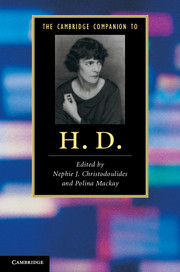7 - H.D.'s transformative poetics
from PART II - WORKS
Published online by Cambridge University Press: 28 November 2011
Summary
At the heart of Sea Garden, H.D.'s first published book, is the desire:
… to find a new beauty
in some terrible
wind-tortured place.
Published in 1916, in the midst of war, Sea Garden is a site of conflict and of transformation. Its very title is contradictory, like Sappho's celebrated oxymoron bittersweet, which resonates through this and subsequent volumes in expressions like ‘scented and stinging/ … sweet and salt’ (H.D., CP, p. 36). In an inspired essay, Eileen Gregory has asserted that the poet Sappho is a ‘latent mythicpresence’ in Sea Garden, while I have suggested elsewhere that a Sapphic aesthetic of variegation patterns this poetry and is carried into H.D.'s later work. Both insights identify her poetics with an ancient tradition, reaching back to the pre-classical era in Greece, but also active in renaissance England.
H.D.'s way of writing is very old, but it is also very new, with the shocking, iconoclastic newness that prefers rupture to perfection, kinesis to stasis. Ezra Pound immediately recognised this and, as he turned his attention from imagism to Vorticism, used H.D.'s ‘Oread’ to illustrate its aesthetic of moving energies. That much-anthologised poem is not in Sea Garden, but contemporary with it, like the rest of those gathered in The God. The poetry of this early period, which is the foundation of all H.D.'s later work, is modern in its abruptness and brevity, its unpredictable open form, its natural language, its inherent riskiness.
- Type
- Chapter
- Information
- The Cambridge Companion to H. D. , pp. 93 - 112Publisher: Cambridge University PressPrint publication year: 2011
- 1
- Cited by

